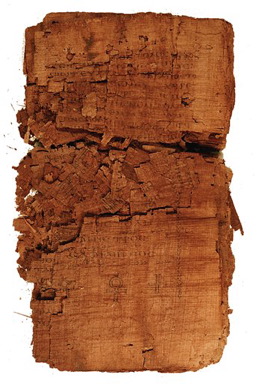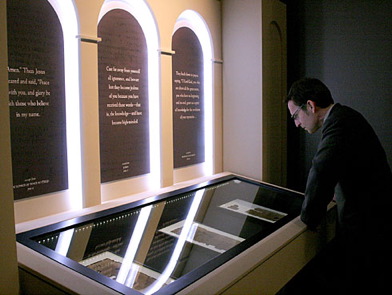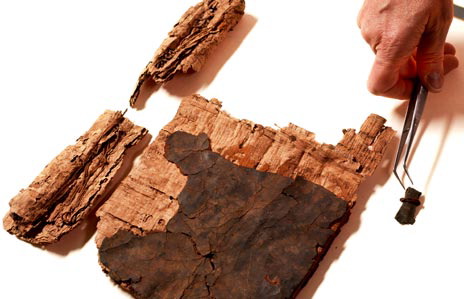Final Thoughts (for now) on the Gospel of Judas
First...regarding the cover...
I noticed this immediately. From the early publicity on the National Geographic website, the Gospel of Judas was prominently featured on the May 2006 cover. However, the actual cover I got in the mail features polar bears from an article about drilling for oil in Alaska. See for yourself:

Above: the May 2006 cover as depicted on the website (left)
vs. the cover that actually came in the mail (right).
Why the change? Well, there are two possibilities. Perhaps National Geographic has released two different covers for this issue. Magazines are often known to do this. I haven't been to a newsstand to check if there are different covers.
OR perhaps by the actual publication date, a decision was made to change the cover and thus downplay the story. The National Geographic Society has received so much negative attention recently over the way the manuscript was acquired, that this would certainly be a possibility.
Secondly, I was disappointed in the length of the article (full text here). If you don't count the full-page spreads of pictures, there's really only about eight or nine pages. And the story only briefly describes the contents before focusing on the acquirement and restoration of the text. Perhaps they want you to watch the video presentation to get more detail. I admit that I haven't seen it yet. We don't get the National Geographic Channel (although I wish we did). I'll have to wait until the public library gets a copy of the video before I see it.
Also I thought this was very interesting--there's an Egyptian ankh (instead of a more traditional cross) at the bottom of the codex. I never noticed it from the online pictures, but there's a full-page shot in the article. Here's the largest one I could find online. Look near the bottom.

Perhaps since the the text is in Coptic it's normal to have the ankh. It just took me by surprise when I saw it in the magazine.
A couple of outrageous quotes:
The article cites Bart Ehrman as saying "This is big ... a lot of people are going to be upset." Well, probably not, Bart. If you go to http://news.google.com/ and do a simple search for "gospel of Judas," you'll find that majority of the articles listed (and there are hundreds) are fairly dismissive. It certainly doesn't seem that folks are getting all that upset over it.
Frieda Nussberger-Tchacos, the final buyer of the gospel, is quoted as saying "Everything is predestined. I myself was predestined by Judas to rehabilitate him."
Yeah... good luck with that...
Previous blogs on the Gospel of Judas:
The Gospel of Judas: What They Don't Want You to Know
My Argument Against the Gospel of Judas: Let Me Clarify for My Critics in Taipei
Irenaeus and the Gospel of Judas
Irenaeus and the Gospel of Judas

Is the Gospel of Judas that is receiving so much attention this week the same Gospel of Judas mentioned by Irenaeus, a second-century bishop and apologist for the faith? Some want to claim that it is thereby cementing a date of writing for the Gospel of Judas at least as early as 170-180 AD--as if an earlier date would add to its credibility. Having looked at Irenaeus' words on the the subject, I'm not convinced they're one and the same.
In Against Heresies, ch. 31 Irenaeus devotes his attention to a gnostic group that he calls "the Cainites." Below is his description of the groups' teachings as recorded in the particular extra-biblical Gospel of Judas with which he is familiar.
Others again declare that Cain derived his being from the Power above, and acknowledge that Esau, Korah, the Sodomites, and all such persons, are related to themselves. On this account, they add, they have been assailed by the Creator, yet no one of them has suffered injury. For Sophia was in the habit of carrying off that which belonged to her from them to herself. They declare that Judas the traitor was thoroughly acquainted with these things, and that he alone, knowing the truth as no others did, accomplished the mystery of the betrayal; by him all things, both earthly and heavenly, were thus thrown into confusion. They produce a fictitious history of this kind, which they style the Gospel of Judas. (Irenaeus, Against Heresies 31:1)
Now, if you downloaded the National Geographic Society's translation of the Gospel of Judas and actually read any of it, you may have noticed that much of what Irenaeus describes above is not found in the document we currently have. There is no mention of Esau, Korah, or the Sodomites. Most significantly, there is no mention of Cain which is supposed to be a core figure in the history Irenaeus says is described in the Gospel of Judas with which he is familiar. Yes, Sophia (as the personification of wisdom) is mentioned, but that is fairly common for many of these gnostic writings.
Now to be fair, you may have noticed that the Gospel of Judas manuscript we have is incomplete. Perhaps, some of these missing features are found in the parts of the text that are missing. Maybe...but maybe not. I'm not an expert in these things by any means, but I've read my share of Gnostic writings, and the Gospel of Judas that we currently have certainly feels like the Nag Hammadi texts of a century later such as the infamous Gospel of Thomas.
But let's play devil's advocate for a minute. What if it was earlier? What if it is the same as Irenaeus's Gospel of Judas and thus it is decidedly given a second century date. Does this matter? Should we join in with the sensationalistic view that perhaps the Gospel of Judas is a contender as a fifth gospel?
In a word...no.
There are New Testament references to other writings that aren't in our New Testament. There's at least one other letter written by Paul to the Corinthians that we don't have. There is a letter he wrote to the Laodiceans. But even if we found these letters, they wouldn't warrant inclusion into the New Testament because they were rejected by the early church as being neither authoritative nor inspired. That's probably also why we don't have these letters anymore. And the Gospel of Judas was probably considered insignificant in its time or immediately afterwards, which is why we have only one extant copy to this day and why it took 1700 years to find it. And there are dozens of other writings by Christians, even much earlier than the Gospel of Judas that did not make it into the New Testament. Consider the Shepherd of Hermas, the Didache, the Epistle of Barnabas. Although these are edifying reading, they are not considered inspired or authoritative.
The reason that the Gospel of Judas does not warrant inclusion into the New Testament is because the New Testament canon is closed. This is a matter of theology and history. Even if it were determined that the Gospel of Judas was written in the first century, it still would not qualify for inclusion into the NT. The early church had certain litmus tests for what was chosen to stand alongside the Hebrew Scriptures as sacred canon. This included whether or not a document was written by an apostle or at least by someone who had direct access to apostolic witness. Also there was the issue of whether or not the early church viewed a writing as authoritative and bearing the marks of being inspired by the Holy Spirit.
As I directed in the previous post, I still recommend F. F. Bruce's The Canon of Scripture as highly recommended reading on the subject of why our New Testament takes its final form.
I'll admit that the discovery and translation gospel of Judas is interesting. I've probably downplayed that fact in reaction to all the unnecessary hype that the document is receiving.
And I agree that it should be studied further. But I believe it should be studied for what it is--a representative of 3rd/4th century Gnostic writings, not a contender for a fifth gospel in the New Testament.
My Argument Against the Gospel of Judas: Let Me Clarify for My Critics in Taipei

Above: A section of the document in question with the name "Judas" in Coptic letters.
I noticed this morning that my website was receiving a number of hits from Taipei, the capital in Taiwan. I followed the referring link to discover my article below discounting the Gospel of Judas was being discussed in a Taiwanese forum. See for yourself at http://ubb.frostyplace.com.tw/viewtopic.php?p=122664
Since I don't read Chinese, I couldn't follow any of it except for a post written in English by an individual named "fuigo." Here is what he said:
I don't know. This person seems a bit extreme.
I haven't checked out the National Geographic website, but on NY Times, it is mentioned that the so-called Gospal of Judas is a work done later in a different language in line with the culture and tradtition during that era. This person's sweeping claim that this Gospel of Judas is not a contender for a place in Scripture is not convincing. The fact that this document is not made old enough doesn't automatically mean there isn't one made earlier. I honestly do not understand the author's logic.
The author goes on and explains Gnosticism. He defined it as a cult; similarly, NY Times mentions Gnosticism as a group people who could escape the prisons of their material bodies and return to the spiritual realm from which they came[sic]. As NY Time points out, Gnostics' beliefs are often considered by early church leaders as unorthodox or even denounced as heretics. I also do not see how this could immediately eliminate the validity of this piece of work.
Anyway, I am babbling. I would like to see more research done on this before I make any judgements.
I tried my best to create an account and reply directly in this forum, but despite my best guesses in dealing with the new account form, I never had any luck getting logged in. Too bad I don't read Chinese.
However, I was able to email fuigo. Here is what I wrote:
Maybe I wasn't clear in my argument. But the gospels as contained in the New Testament were eyewitness accounts of the life of Christ. This document is definitely later. We know this not just by the carbon dating--you are right, it could just be a later copy of an earlier work. But rather, the theological content is gnostic in nature and comes from at least a century later, if not probably more, than any of the eyewitness accounts in the New Testament. No one, and I mean no one--not even those who are excited about the Gospel of Judas--truly believe that there's anyway it could date from the first century.
Gnosticism as described in the Gospel of Judas and in the Nag Hammadi codices simply didn't exist anywhere in the first century. It's not an eyewitness account, so it's not historical. It's the writings of a very small group of believers who broke away from orthodoxy. The fact that we have only one copy of the Gospel of Judas compared with tens of thousands of copies of accepted New Testament manuscripts demonstrate that the church did not value this writing as genuine. ALL New Testament writings were written in the first generation of Christianity by eyewitnesses to the events described. The Gospel of Judas, while interesting in the study of this gnostic sect, is of no value to New Testament studies.
I don't have time to do it right now, but perhaps this summer, there would be a need to blog about the process of selection and canonization of the New Testament manuscripts. In the meantime, I wholeheartedly recommend the book, The Canon of Scripture by F. F. Bruce. This is one of the best sources I know to go to regarding the origins of our New Testament.
Oh, and fuigo, thanks for labeling me "extreme" simply because I disagree with all the non-scholarly, sensationalistic hype surrounding an insignificant gnostic manuscript.
The Gospel of Judas: What They Don't Want You to Know

This Sunday, April 9, the National Geographic channel will air a documentary detailing the discovery and translation of the so-called "Gospel of Judas." Tonight, I watched a preview of sorts in a segment on ABC's Primetime Live. If you go to the link I just provided and play the online video segment, you will hear an ABC correspondent say that "The Bible as we know it will be changed forever."
Really?
Really?
Well, don't count on it. During the Primetime segment, the question was asked as to whether or not Judas was actually the betrayer of Jesus as the Gospels in the New Testament portray him to be. According to the report, in this ancient document, Jesus himself asks Judas to betray him--to free his soul from the confines of his earthly body. Now, I've read the the translation of the Gospel of Judas that the National Geographic Society is providing. I can't actually find any place where Jesus asks Judas to betray him. Granted, there's lots of talk where Jesus says Judas will be misunderstood and persecuted, but later exalted for what he does (definitely a different take than the canonical gospels), but I don't read where Jesus actually asks Judas to do the deed.
Here's the closest you get to it:
Judas said to Jesus, “Look, what will those who have been baptized in your name do?”
Jesus said, “Truly I say [to you], this baptism [56] […] my name [—about nine linesmissing—] to me. Truly [I] say to you, Judas, [those who] offer sacrifices to Saklas […]God [—three lines missing—] everything that is evil.
“But you will exceed all of them. For you will sacrifice the man that clothes me.
Already your horn has been raised,
your wrath has been kindled,
your star has shown brightly,
and your heart has […]. [57]
“Truly […] your last […] become [—about two and a half lines missing—], grieve[—about two lines missing—] the ruler, since he will be destroyed. And then the imageof the great generation of Adam will be exalted, for prior to heaven, earth, and the angels,that generation, which is from the eternal realms, exists. Look, you have been toldeverything. Lift up your eyes and look at the cloud and the light within it and the starssurrounding it. The star that leads the way is your star.”
Judas lifted up his eyes and saw the luminous cloud, and he entered it. Those standingon the ground heard a voice coming from the cloud, saying, [58] […] great generation[…] … image […] [—about five lines missing—].
Now, in spite of the fact that ABC and the National Geographic Society (it makes me ashamed to admit I'm a member) are grossly exaggerating the content of the text, there is one extremely important fact about the document that is being downplayed in all the uproar. And it's something you need to know. In fact, I would dare say that it's the most significant fact about the so-called Gospel of Judas.
What is it?
Well, what you need to know is the date that this gospel was written. The Primetime Live segment never mentioned a date. And you really have to look hard to find this information on the National Geographic site. In fact, they tend to date it in reverse by saying that it is a 1700 year-old document. Here's what's really important, folks: The Gospel of Judas was written in the 3rd Century AD.
When were the gospels that are found in the New Testament written? They were written in the first century. To be exact, I personally believe they were written sometime between the mid-50's to the mid-60's. But hardly any scholar these days would date them past the mid-seventies (although there are a few holdouts who would date John to the 90's). Regardless, everyone gives them a first century date.
So what does that mean? Well, it means that the Gospel of Judas was not a contender for a place in Scripture. It was not excluded from the New Testament by any secret conspiratorial committee in the early church who didn't approve of its content or message. It was written two-hundred years or more after the New Testament.
The Gospel of Judas has more in common with the Nag Hammadi writings discovered in 1945 than with anything in the New Testament. What were the Nag Hammadi writings? They were a group of codices written in Coptic around the third or fourth century AD and contained what is known as gnostic Christian writings. Gnostic writings were a combination of Christianity, Greek Platonic thought, and mystery religions. Salvation was found through secret knowledge, and the ultimate goal was to be relieved of the body (which was seen as evil) so that the soul could take its rightful place in heaven. The Gnostics were essentially a Christian cult and from a contemporary perspective, you could group them with modern cults such as the Moonies or the Branch Davidians.
Is the Gospel of Judas a significant find? Well, in spite of all the hype, no, it's not! It's only of interest to those who study ancient history, specifically the weird and far-out teachings of the Gnostics. But Gnostic writings of the third and fourth centuries have NO bearing on New Testament studies.
Look, people need to get it into their heads that there's no smoking gun from the days of the early church. There was no conspiracy to hide the truth from some fifth or sixth of seventh gospel. There was no plot to hide a secret marriage of Jesus to Mary Magdalene and other Da Vinci Code conspiracy nonsense.
Besides the fact that the Gospel of Judas comes too late to even be considered for inclusion into the New Testament Canon, simply reading it reveals that it's of a completely different nature, character and flavor than the rest of the biblical writings. And that's true for most of the apocrypha and pseudipigrapha and other stuff that didn't make the "cut" for the Canon.
But if you want to get it all out of your system, I encourage you to read this ancient esoteric nonsense for yourself. I'm including below the National Geographic's translation of the Gospel of Judas. You read this, and then tell me if you honestly want this appended to the 27 books in the New Testament you are now carrying.
Download The Gospel of Judas:
GospelofJudas









